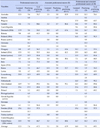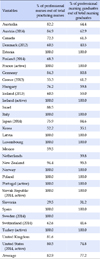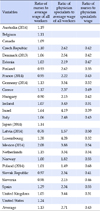Abstract
Purpose
This study aims to report on and compare the conditions of practicing nurses and nursing graduates in Korea and other OECD countries to suggest policy to improve nurse staffing in Korea.
Methods
Data on nurses and nursing graduates from 34 OECD countries in 2015 (or the nearest year) were analyzed. The proportion of practicing nurses among nurses who were licensed to practice and nursing graduates per population and per the number of practicing nurses were examined.
Results
The number of practicing nurses per 1,000 population in Korea was 5.9 and, in Korea, only 31.0% of licensed nurses were practicing, whereas the OECD average was 69.5%. Korea had the highest number of nursing graduates (109.0) per 100,000 population and the highest number of nursing graduates (183.5) per 1,000 practicing nurses in the OECD countries. Skill-mix analysis indicated that 52.2% of the practicing nurses in Korea were professional practicing nurses, which was the second-lowest among the OECD countries. The ratio of nurses' wages to those of physician specialists was 0.43 in the OECD countries.
Figures and Tables
Table 1
Licensed and Practicing Nurses per 1,000 Population in 2015 or Nearest Year among 34 OECD Countries

References
1. Aiken LH, Clarke SP, Sloane DM, Sochalski J, Silber JH. Hospital nurse staffing and patient mortality, nurse burnout, and job dissatisfaction. JAMA. 2002; 288(16):1987–1993. DOI: 10.1001/jama.288.16.1987.

2. Cimiotti JP, Aiken LH, Sloane DM, Wu ES. Nurse staffing, burnout, and health care-associated infection. Am J Infect Control. 2012; 40(6):486–490. DOI: 10.1016/j.ajic.2012.02.029.

3. Kane RL, Shamliyan TA, Mueller C, Duval S, Wilt TJ. The association of registered nurse staffing levels and patient outcomes: systematic review and meta-analysis. Med Care. 2007; 45(12):1195–1204. DOI: 10.1097/MLR.0b013e3181468ca3.

4. Korean Nurses Association. Nursing education institutions [Internet]. Seoul: Korean Nurses Association;2017. 06. 30. cited 2017 Sep 8. Available from: http://www.koreanurse.or.kr/board/board.php?board=research.
5. Bae HJ. Influence of the expansion of entrance quota for nursing programs on rural · small sized hospitals [dissertation]. Seoul: Seoul National University;2016.
6. Oh YH. The demand and supply of registered nurses in Korea and policy recommendations. Res Health Soc. 2008; 28(1):68–86.

7. OECD. OECD health statistics [Internet]. Paris: Organisation for Economic Co-operation and Development;2017. 06. 30. cited 2017 Sep 8. Avaliable from: http://www.oecd.org/els/health-systems/health-data.htm.
8. OECD. Health at a glance 2015: OECD indicators [Internet]. Paris: Organisation for Economic Co-operation and Development;2015. 11. cited 2017 Sep 8. Available from: https://doi.org/10.1787/health_glance-2015-en.
9. Hong KJ, Cho S-H. Changes in nurse staffing grades in general wards and adult and neonatal intensive care units. J Korean Clin Nurs Res. 2017; 23(1):64–72. DOI: 10.22650/JKCNR.2017.23.1.64.
10. OECD. OECD Health statistics 2017 definitions, sources and methods [Internet]. Paris: Organisation for Economic Co-operation and Development;2017. 06. 30. cited 2017 Sep 8. Avaliable from: http://www.oecd.org/els/health-systems/health-data.htm.
11. Ministry of Health and Welfare. Ministry of Health and Welfare statistical year book 2015 [Internet]. Sejong: Ministry of Health and Welfare;2015. 12. 15. cited 2017 Sep 8. Avaliable from: http://www.mohw.go.kr/front_new/jb/sjb030301vw.jsp?PAR_MENU_ID=03&MENU_ID=032901&CONT_SEQ=337347&page=1.
12. Cho S-H, June KJ, Kim YM, Park BH. Changes in hospital nurse staffing after implementing differentiated inpatient nursing fees by staffing grades. J Korean Acad Nurs Adm. 2008; 14(2):167–175.
13. Kim YM, Kim J, June KJ, Ham EO. Changing trend in grade of nursing management fee by hospital characteristics: 2008-2010. J Korean Clin Nurs Res. 2010; 16(3):99–109.
14. Choi HM, Han N-K, Lee S-K, Kim H-S, Choi S, Chung W. Study on factors associated with the rise in grade of nursing management fee among korean hospitals. Health Policy Manag. 2015; 25(1):40–52. DOI: 10.4332/KJHPA.2015.25.1.40.

15. Jourdain G, Chênevert D. Job demands-resources, burnout and intention to leave the nursing profession: A questionnaire survey. Int J Nurs Stud. 2010; 47(6):709–722. DOI: 10.1016/j.ijnurstu.2009.11.007.

16. Cho SH, Lee J-Y, June K-J, Hong KJ, Kim Y. Nurse staffing levels and proportion of hospitals and clinics meeting the legal standard for nurse staffing for 1996~2013. J Korean Acad Nurs Adm. 2016; 22(3):209–219. DOI: 10.11111/jkana.2016.22.3.209.

17. Nam SJ, Yang IS, Kim YA, Shin SJ, Choi HR, Cho YH, et al. The survey for working conditions of clinical nurses [Internet]. Seoul: Hospital Nurses Association;2016. 02. 19. cited 2017 Sep 8. Avaliable from: http://khna.or.kr/web/information/resource.php.
18. Yoon HJ, Cho S-H. Geographic mobility and related factors among newly graduated nurses. J Korean Acad Soc Nurs Educ. 2017; 23(3):353–362. DOI: 10.5977/jkasne.2017.23.3.353.

19. Ministry of Health and Welfare. Press release from Ministry of Health and Welfare [Internet]. Sejong: Ministry of Health and Welfare;2017. 05. 08. cited 2017 Sep 8. Avaliable from: http://www.mohw.go.kr/front_new/al/sal0301vw.jsp?PAR_MENU_ID=04&MENU_ID=0403&CONT_SEQ=339529&page=1.




 PDF
PDF ePub
ePub Citation
Citation Print
Print





 XML Download
XML Download